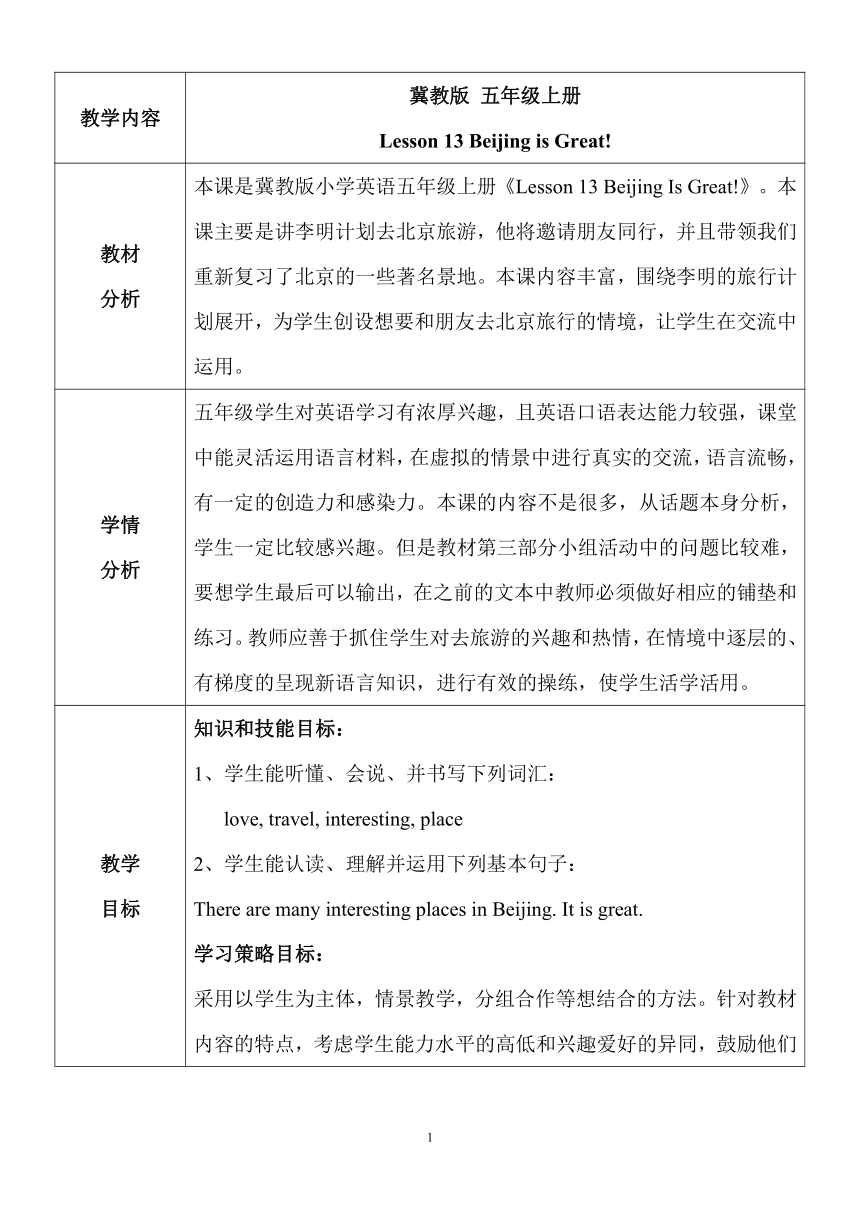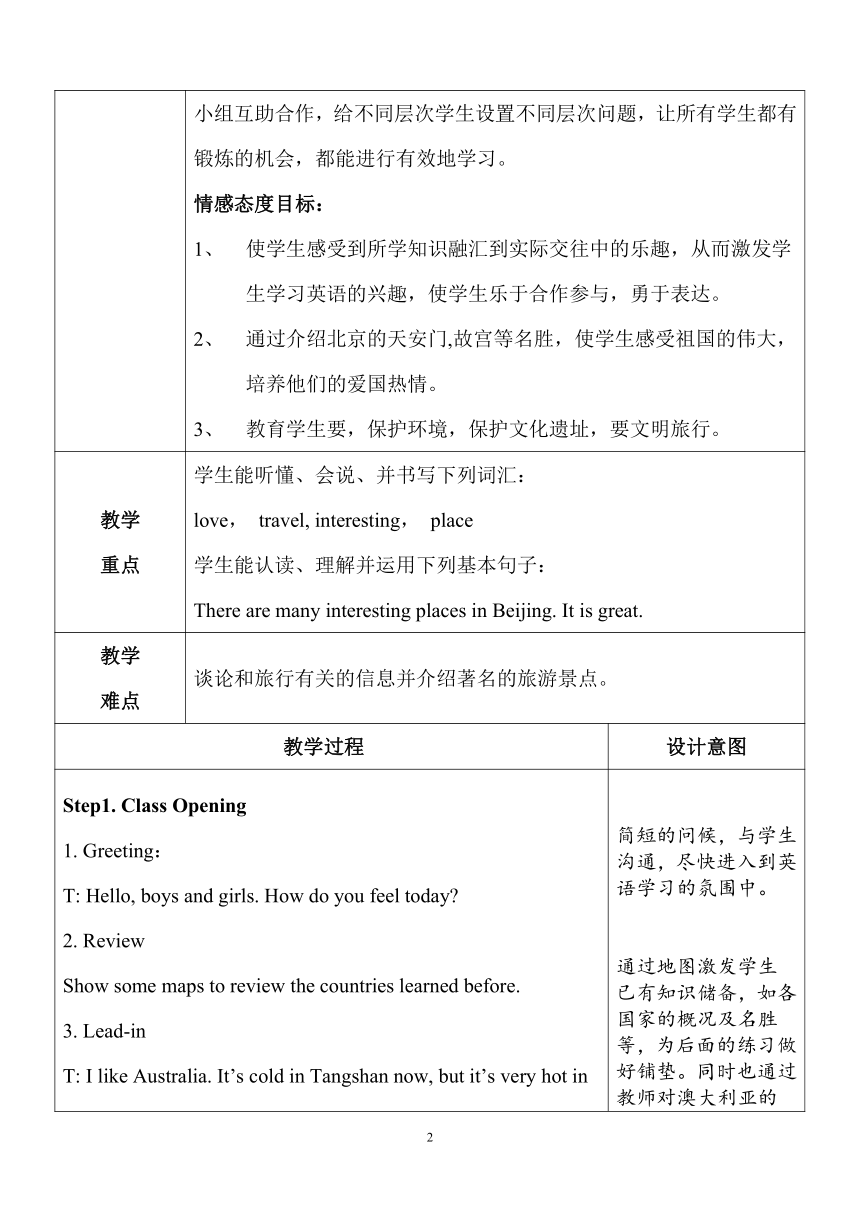Lesson 13 Beijing is Great 表格式教案
文档属性
| 名称 | Lesson 13 Beijing is Great 表格式教案 |  | |
| 格式 | zip | ||
| 文件大小 | 12.7KB | ||
| 资源类型 | 教案 | ||
| 版本资源 | 冀教版(三年级起点) | ||
| 科目 | 英语 | ||
| 更新时间 | 2020-01-01 13:36:29 | ||
图片预览


文档简介
教学内容
冀教版 五年级上册
Lesson 13 Beijing is Great!
教材
分析
本课是冀教版小学英语五年级上册《Lesson 13 Beijing Is Great!》。本课主要是讲李明计划去北京旅游,他将邀请朋友同行,并且带领我们重新复习了北京的一些著名景地。本课内容丰富,围绕李明的旅行计划展开,为学生创设想要和朋友去北京旅行的情境,让学生在交流中运用。
学情
分析
五年级学生对英语学习有浓厚兴趣,且英语口语表达能力较强,课堂中能灵活运用语言材料,在虚拟的情景中进行真实的交流,语言流畅,有一定的创造力和感染力。本课的内容不是很多,从话题本身分析,学生一定比较感兴趣。但是教材第三部分小组活动中的问题比较难,要想学生最后可以输出,在之前的文本中教师必须做好相应的铺垫和练习。教师应善于抓住学生对去旅游的兴趣和热情,在情境中逐层的、有梯度的呈现新语言知识,进行有效的操练,使学生活学活用。
教学
目标
知识和技能目标:
1、学生能听懂、会说、并书写下列词汇:
love, travel, interesting, place
2、学生能认读、理解并运用下列基本句子:
There are many interesting places in Beijing. It is great.
学习策略目标:
采用以学生为主体,情景教学,分组合作等想结合的方法。针对教材内容的特点,考虑学生能力水平的高低和兴趣爱好的异同,鼓励他们小组互助合作,给不同层次学生设置不同层次问题,让所有学生都有锻炼的机会,都能进行有效地学习。
情感态度目标:
使学生感受到所学知识融汇到实际交往中的乐趣,从而激发学生学习英语的兴趣,使学生乐于合作参与,勇于表达。
通过介绍北京的天安门,故宫等名胜,使学生感受祖国的伟大,培养他们的爱国热情。
教育学生要,保护环境,保护文化遗址,要文明旅行。
教学
重点
学生能听懂、会说、并书写下列词汇:
love, travel, interesting, place
学生能认读、理解并运用下列基本句子:
There are many interesting places in Beijing. It is great.
教学
难点
谈论和旅行有关的信息并介绍著名的旅游景点。
教学过程
设计意图
Step1. Class Opening
1. Greeting:
T: Hello, boys and girls. How do you feel today?
2. Review
Show some maps to review the countries learned before.
3. Lead-in
T: I like Australia. It’s cold in Tangshan now, but it’s very hot in Australia. And there’re many beautiful beaches there. So I want to go to Australia. I like to travel.
Step 2. New Concepts and practice
1. “I love to travel.”
T: Does Li Ming like to travel? Let’s listen.
教读travel并板书
T: Li Ming likes to travel. He loves to travel.
板书 love 并教读love to travel
T: Do you love to travel?
Choose two or three students to ask and answer about“Do you love to travel? Yes, I love to travel.”
2.“I want to go to Beijing. I want Danny and Jenny to come.”
(1)引出文本
T: Li Ming loves to travel. Where does he want to go? Who does he want to go with? Let’s Listen.
Then ask students to answer and check the answers.
(2)Practice
T: Show the picture of the five kids and ask “Who are they? Do they love to travel? Who do they want to go with?(学生可以直接回答) Where do they want to go?(play the video)”
They want to go to a place in Yunnan. Puzhehei is a place in Yunnan.
Show another picture about them. The teacher ask:“Where do they want to go this time? Guess please!(show a map of China to help them.) ”
(3) Ask students to work in pairs to practice the sentences of “Do you love to travel? Where do you want to go? Who do you want to go with?”
3. “There are many interesting places in Beijing.”
(1). “interesting place”
T: Where does Li Ming want to go? What does Li Ming know about Beijing? Are there any famous places in Beijing? What are they? Please read your books on P38 and find the answers.
T:(播放视频、图片)What can you see? What can you do in/on…Is it beautiful? …
So…is interesting. … is an interesting place.
(2)“There are….”
T: Are there other interesting places in Beijing? What are they?
教师示范,学生两人一组练习。(给出部分图片提示,但不限制学生思维)
T: There are many interesting places in Beijing. 板书并带着感情齐读。从而体会到北京的伟大,并板书标题Beijing is Great!引导学生自豪地齐读标题。
Step 3. Listening and reading.
Listen and repeat
Read Part 1 and write.
Step 4. Extension and practice
Show more interesting places and let students to practice in pairs (Let’s do it: part 2)and let them show themselves in front.
Step 5. Class Closing
We love to travel. I hope when we leave the interesting places, we should keep there clean and beautiful. We should protect the environment and protect the legacy of monuments. We should be civilized travel. I believe we can do it!
Step 6. Homework
Please talk about the questions on P39 with your parents or good friends.
板书设计
Lesson 13 Beijing is Great!
I love to travel!
There are many interesting places in Beijing.
(四会单词要用彩色粉笔标注)
简短的问候,与学生沟通,尽快进入到英语学习的氛围中。
通过地图激发学生已有知识储备,如各国家的概况及名胜等,为后面的练习做好铺垫。同时也通过教师对澳大利亚的喜欢引出本课第一个四会单词travel.
通过学生的听引出文本。
Love一词,大部分同学都很熟悉,所以通过like的意思直接引入。
通过简单的三次问答,机械操练I love to travel.
让学生带着问题去听,让学生听的更有目的性。
通过“爸爸去哪儿”的图片及视频很好地调动学生的学习热情,不仅练习了问答句,还让学生从中理解place 一词的意思。
“猜”这个环节不仅再次调动了学生的学习积极性,而且在问答句中反复练习了place 一词。
俩人合作练习已学的三个问答句,为最后的输出做好铺垫,也培养了学生互助合作的学习能力。
此部分有关名胜的内容,学生在第二单元已经学过,所以通过阅读的方式让学生自主获得所需知识,锻炼学生自主学习的能力。
通过多种形式让学生体会到故宫、天安门和长城的有名有趣,让学生体会到interesting 的含义,并会应用interesting place这个短语练习。
此部分既为第3部分的对话输出做好铺垫,同时也是对北京名胜的拓展和补充,更能让学生体会到北京的伟大,培养学生的爱国之情,从而引出本课标题。
学生通过跟读录音,模仿纯正的语音、语调,更好地理解和复习新语言。
最后的对话练习培养了学生英语思维及互助学习模式,通过真实的情景交际也能增进同学情谊,为语言的运用打下良好基础。
最后教育学生要文明旅行,要保护我们的文物古迹,保护环境,热爱祖国。
作业的布置体现了英语学习的目的是在真实的情景交际中去运用语言。
冀教版 五年级上册
Lesson 13 Beijing is Great!
教材
分析
本课是冀教版小学英语五年级上册《Lesson 13 Beijing Is Great!》。本课主要是讲李明计划去北京旅游,他将邀请朋友同行,并且带领我们重新复习了北京的一些著名景地。本课内容丰富,围绕李明的旅行计划展开,为学生创设想要和朋友去北京旅行的情境,让学生在交流中运用。
学情
分析
五年级学生对英语学习有浓厚兴趣,且英语口语表达能力较强,课堂中能灵活运用语言材料,在虚拟的情景中进行真实的交流,语言流畅,有一定的创造力和感染力。本课的内容不是很多,从话题本身分析,学生一定比较感兴趣。但是教材第三部分小组活动中的问题比较难,要想学生最后可以输出,在之前的文本中教师必须做好相应的铺垫和练习。教师应善于抓住学生对去旅游的兴趣和热情,在情境中逐层的、有梯度的呈现新语言知识,进行有效的操练,使学生活学活用。
教学
目标
知识和技能目标:
1、学生能听懂、会说、并书写下列词汇:
love, travel, interesting, place
2、学生能认读、理解并运用下列基本句子:
There are many interesting places in Beijing. It is great.
学习策略目标:
采用以学生为主体,情景教学,分组合作等想结合的方法。针对教材内容的特点,考虑学生能力水平的高低和兴趣爱好的异同,鼓励他们小组互助合作,给不同层次学生设置不同层次问题,让所有学生都有锻炼的机会,都能进行有效地学习。
情感态度目标:
使学生感受到所学知识融汇到实际交往中的乐趣,从而激发学生学习英语的兴趣,使学生乐于合作参与,勇于表达。
通过介绍北京的天安门,故宫等名胜,使学生感受祖国的伟大,培养他们的爱国热情。
教育学生要,保护环境,保护文化遗址,要文明旅行。
教学
重点
学生能听懂、会说、并书写下列词汇:
love, travel, interesting, place
学生能认读、理解并运用下列基本句子:
There are many interesting places in Beijing. It is great.
教学
难点
谈论和旅行有关的信息并介绍著名的旅游景点。
教学过程
设计意图
Step1. Class Opening
1. Greeting:
T: Hello, boys and girls. How do you feel today?
2. Review
Show some maps to review the countries learned before.
3. Lead-in
T: I like Australia. It’s cold in Tangshan now, but it’s very hot in Australia. And there’re many beautiful beaches there. So I want to go to Australia. I like to travel.
Step 2. New Concepts and practice
1. “I love to travel.”
T: Does Li Ming like to travel? Let’s listen.
教读travel并板书
T: Li Ming likes to travel. He loves to travel.
板书 love 并教读love to travel
T: Do you love to travel?
Choose two or three students to ask and answer about“Do you love to travel? Yes, I love to travel.”
2.“I want to go to Beijing. I want Danny and Jenny to come.”
(1)引出文本
T: Li Ming loves to travel. Where does he want to go? Who does he want to go with? Let’s Listen.
Then ask students to answer and check the answers.
(2)Practice
T: Show the picture of the five kids and ask “Who are they? Do they love to travel? Who do they want to go with?(学生可以直接回答) Where do they want to go?(play the video)”
They want to go to a place in Yunnan. Puzhehei is a place in Yunnan.
Show another picture about them. The teacher ask:“Where do they want to go this time? Guess please!(show a map of China to help them.) ”
(3) Ask students to work in pairs to practice the sentences of “Do you love to travel? Where do you want to go? Who do you want to go with?”
3. “There are many interesting places in Beijing.”
(1). “interesting place”
T: Where does Li Ming want to go? What does Li Ming know about Beijing? Are there any famous places in Beijing? What are they? Please read your books on P38 and find the answers.
T:(播放视频、图片)What can you see? What can you do in/on…Is it beautiful? …
So…is interesting. … is an interesting place.
(2)“There are….”
T: Are there other interesting places in Beijing? What are they?
教师示范,学生两人一组练习。(给出部分图片提示,但不限制学生思维)
T: There are many interesting places in Beijing. 板书并带着感情齐读。从而体会到北京的伟大,并板书标题Beijing is Great!引导学生自豪地齐读标题。
Step 3. Listening and reading.
Listen and repeat
Read Part 1 and write.
Step 4. Extension and practice
Show more interesting places and let students to practice in pairs (Let’s do it: part 2)and let them show themselves in front.
Step 5. Class Closing
We love to travel. I hope when we leave the interesting places, we should keep there clean and beautiful. We should protect the environment and protect the legacy of monuments. We should be civilized travel. I believe we can do it!
Step 6. Homework
Please talk about the questions on P39 with your parents or good friends.
板书设计
Lesson 13 Beijing is Great!
I love to travel!
There are many interesting places in Beijing.
(四会单词要用彩色粉笔标注)
简短的问候,与学生沟通,尽快进入到英语学习的氛围中。
通过地图激发学生已有知识储备,如各国家的概况及名胜等,为后面的练习做好铺垫。同时也通过教师对澳大利亚的喜欢引出本课第一个四会单词travel.
通过学生的听引出文本。
Love一词,大部分同学都很熟悉,所以通过like的意思直接引入。
通过简单的三次问答,机械操练I love to travel.
让学生带着问题去听,让学生听的更有目的性。
通过“爸爸去哪儿”的图片及视频很好地调动学生的学习热情,不仅练习了问答句,还让学生从中理解place 一词的意思。
“猜”这个环节不仅再次调动了学生的学习积极性,而且在问答句中反复练习了place 一词。
俩人合作练习已学的三个问答句,为最后的输出做好铺垫,也培养了学生互助合作的学习能力。
此部分有关名胜的内容,学生在第二单元已经学过,所以通过阅读的方式让学生自主获得所需知识,锻炼学生自主学习的能力。
通过多种形式让学生体会到故宫、天安门和长城的有名有趣,让学生体会到interesting 的含义,并会应用interesting place这个短语练习。
此部分既为第3部分的对话输出做好铺垫,同时也是对北京名胜的拓展和补充,更能让学生体会到北京的伟大,培养学生的爱国之情,从而引出本课标题。
学生通过跟读录音,模仿纯正的语音、语调,更好地理解和复习新语言。
最后的对话练习培养了学生英语思维及互助学习模式,通过真实的情景交际也能增进同学情谊,为语言的运用打下良好基础。
最后教育学生要文明旅行,要保护我们的文物古迹,保护环境,热爱祖国。
作业的布置体现了英语学习的目的是在真实的情景交际中去运用语言。
同课章节目录
- Unit 1 My family
- Lesson 1 Li Ming's Big Family
- Lesson 2 What Do They Look Like?
- Lesson 3 What Do They Do?
- Lesson 4 What Do They Like to Do?
- Lesson 5 Having Fun Togethe
- Lesson 6 Maddy's Famliy
- Unit 2 My Country and English-speaking Countries
- Lesson 7 China
- Lesson 8 Canada
- Lesson 9 The U.S
- Lesson 10 The U.K.
- Lesson 11 Australia
- Lesson 12 Maddy's Family Photos
- Unit 3 A Travel Plan
- Lesson 13 Beijing is Great
- Lesson 14 May I Go to Beijing ?
- Lesson 15 May I Invite Danny and Jenny?
- Lesson 16 How Can We Go To Beijing?
- Lesson 17 The Travel Plan
- Lesson 18 Billy Bee
- Unit 4 Jenny and Danny Come to China
- Lesson 19 Meet Li Ming's Family
- Lesson 20 The Spring Festival Is Coming!
- Lesson 21 What Year Is It?
- Lesson 22 Special Holidays in China
- Lesson 23 what do we need for the trip
- Lesson 24 Year Animals
